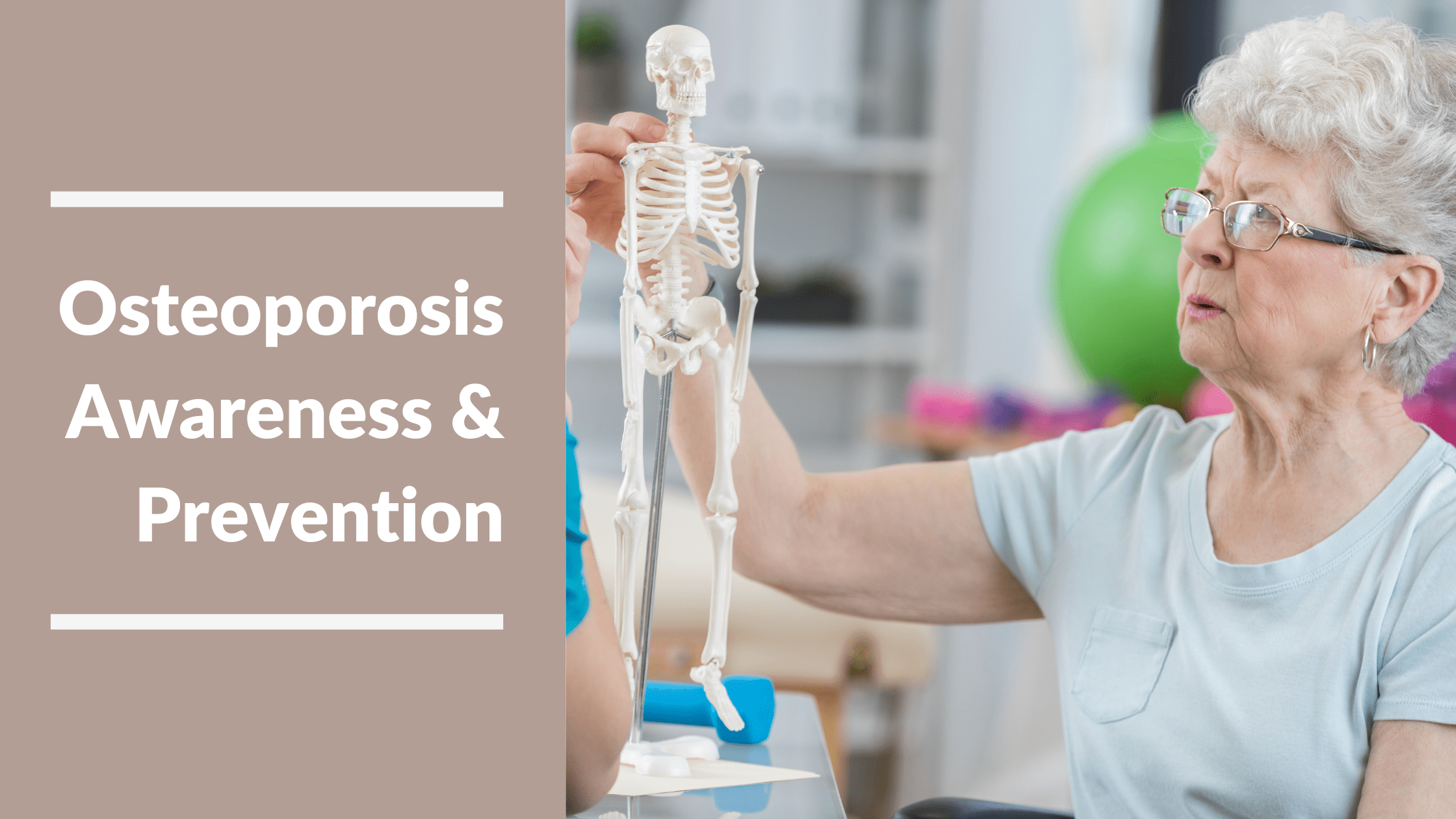
National Osteoporosis Awareness and Prevention Month is the perfect time for older adults to learn about osteoporosis and how they can protect their bone health and promote their health and wellbeing.
Updated June 27, 2022
May Is National Osteoporosis Awareness And Prevention Month
Although many seniors develop this disease, osteoporosis is not a normal part of aging. It is a serious health concern for nearly 44 million – or 55% – of adults over 50. Since osteoporosis is such a common disease, older adults should learn what they can to lower their risk of injury and maintain their quality of life.
What Is Osteoporosis?
Osteoporosis means “porous bone.” Over time, people with this disease lose bone density and bone tissue as it deteriorates.
Nearly 10 million Americans have developed the disease, with an additional 34 million at risk because of low bone mass. In 2005, osteoporotic fractures, which most often occur in the wrists, spine, and hips, incurred a staggeringly high cost of about $19 billion. But in addition to the financial burden, injury can cause mobility and independence loss, which takes a physical, emotional, and mental toll.
Alarmingly, 24% of adults over 50 with an osteoporosis-related fracture die within a year of their injury. Because they can’t feel their bones weakening, older adults may not realize they have it until it is too late – which is why osteoporosis is often called “the silent disease.”
A diagnosis may only come after a minor fall or a fracture caused by a sneeze. Yet, a study by the American Academy of Orthopaedic Surgeons found that despite the detrimental impact on seniors’ quality of life, many at-risk adults know very little about it – sometimes even mistaking osteoporosis-related injuries for something else.
Dr. Angela M. Cheung of the University Health Network/Mount Sinai Hospital Program in Toronto, Ontario, one of the study’s authors, said, “Many people who sustain a fracture don’t connect it to osteoporosis. For example, a person who has a heart attack knows that there’s a problem with his or her heart, but a person who fractures thinks, ‘The floor was slippery’ or ‘I’m clumsy’ and doesn’t look at it as a symptom of a more serious medical condition.”
Osteoporosis Risk Factors
Some people are more predisposed to developing this disease than others. Factors ranging from genetics to lifestyle can increase somebody’s chances, so older adults should talk to their doctor and closely monitor their bone health.
Women have a significantly higher chance of developing osteoporosis than men. On average, 1 in 2 women and 1 in 4 men will break a bone because of this disease. Additionally, certain ethnicities have a higher risk, including Caucasians, Asians, Hispanic/Latinos, and African-Americans.
Older adults with a family history of this disease or who have a history of broken bones also have a higher risk.
Other risk factors of osteoporosis include:
- Older age
- Being small and thin
- Alcohol abuse or smoking
- Inactive or sedentary lifestyle
- Loss of height (which may indicate a spinal fracture)
- Certain diseases and conditions such as anorexia nervosa and asthma
- Certain medications such as steroid medications and some anticonvulsants
- Diet, including low calcium and vitamin D intake and high protein, sodium, and caffeine consumption
- Low sex hormones, such as low estrogen in women (including menopause or missing periods or amenorrhea) and low testosterone and estrogen in men
How To Prevent Osteoporosis
Osteoporosis is a severe health concern, and people should take steps to protect their bone health from an early age.
Teenagers should exercise and make sure they are getting enough vitamin D and calcium. Women, in particular, should learn about preventative measures beginning in their twenties. Doing so will go a long way to keeping their bones healthy and strong later in life.
The best ways older adults can prevent osteoporosis include:
- Meeting the daily recommended intake for calcium (1,200 milligrams) and vitamin D (800 international units)
- Maintaining a healthy diet
- Exercising regularly
Additionally, those who smoke or frequently consume alcohol can lower their risk by changing their lifestyle. Making an appointment to discuss the risk of developing this disease is the first step in prevention and treatment. Adults with more advanced osteoporosis may have to see an endocrinologist or specialist.
Regular Screenings

Regular screening is also an effective measure to catch osteoporosis before it progresses.
The American Association of Clinical Endocrinologists recommends that at-risk adults talk to their doctor about osteoporosis screenings, including:
- All post-menopausal women, as well as those 65 and older
- Those with a history of bone breaks, even non-traumatic ones
- People with brittle bones
- Those taking steroid treatment
- Individuals with low body weight
- Those with a family history, especially women
What To Expect During Osteoporosis Screenings
There are several screening tests that individuals can take.
- A DXA test (or dual-energy x-ray absorptiometry) is the most accurate osteoporosis screening. It helps healthcare professionals assess bone mass.
- A fracture risk assessment is another method doctors use. It includes a discussion of family history, a physical exam, and routine biochemical testing used in combination with the DXA results.
Of course, the goal of osteoporosis treatment is to prevent future injuries caused by broken bones by improving the balance between bone formation and resorption.
MeetCaregivers Supports National Osteoporosis Awareness Month
If you or a loved one need a little extra support during this time, MeetCaregivers can help. Our qualified caregivers can assist with daily needs, transportation, grocery shopping, meal preparation, and more. Call 1 (888) 541-1136 or visit our Find A Caregiver page to get help today.
Visit the Blog for additional resources for caregivers, senior living, and lifestyle.
- Breeding, Dana H. “National Osteoporosis Awareness Prevention Month (May).” National Osteoporosis Awareness Prevention Month (May) | Augusta Health, https://tinyurl.com/yasr72d9.
- Hartley, Simon. “National Osteoporosis Awareness and Prevention Month 2020.” Osteoporosis Awareness and Prevention Month – May 2020, https://tinyurl.com/ns5d2oy.
- Kleifgen, Kevin. “National Osteoporosis Awareness & Prevention Month: Love Your Bones & Keep Them Healthy.” Loyola Medicine, 28 Sept. 2019, https://tinyurl.com/y72o5fpz.
- “A PDF File from CMS Discussing Osteoporosis.”
- “May Is National Osteoporosis Month.” National Osteoporosis Foundation, 24 Apr. 2020, https://tinyurl.com/y9r9nn5w.
- “May Is Osteoporosis Awareness and Prevention Month.” Start Page, https://tinyurl.com/y7ux8sad.
- “National Osteoporosis Month.” National Osteoporosis Foundation, 30 Mar. 2020, https://tinyurl.com/ybmzs629.
